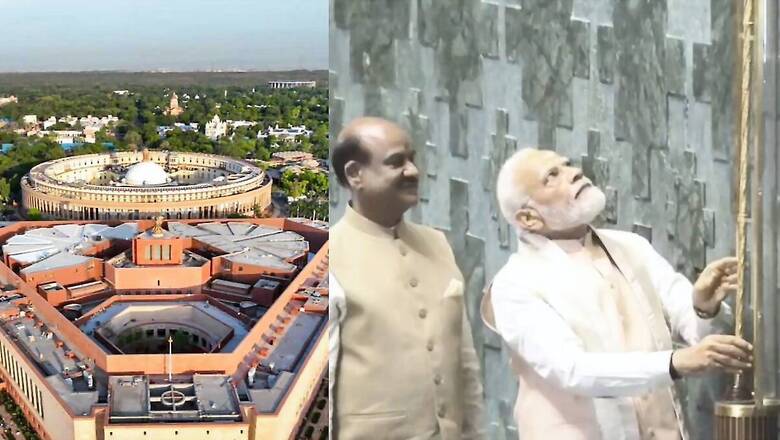
views
For 75 years, no one really found it incongruous that independent India’s lawmakers sat in a building that was built to assert a foreign power’s occupation of this land for 200 years. It was not an expression of free India, but of Imperial Britain. It was not meant to chart the next milestones in India’s millennia-old civilisational journey, but to bestow legitimacy to Britain’s hold over us, which was proved by the fact that it was opened by the British Emperor’s uncle!
That the new Parliament building has been opened today by the elected leader of India, not someone’s uncle, is indisputably a matter of great pride. It is the legitimate self-expression of India, not an idea conceived and articulated architecturally by colonial rulers. The first PM and cabinet can be forgiven for continuing in that building as after Independence there were other pressing demands for scarce funds to build infrastructure.
But India@75 is different.
A country that has now bypassed its former colonial master — Britain — as the world’s fifth largest economy can certainly afford to contemplate and build a Parliament of its own with symbolism commensurate with its stature. A building not dedicated merely to administering India — as was the intention of the Edwin Lutyens-Herbert Baker designed structure — but one that will reflect, legislate and realise her aspirations. And be in tune with the imperatives of a new age.
Amrit Kaal is a very evocative term to encapsulate the aspirations of modern India that is looking ahead and upwards, but rooted in our own experience. A Parliament building that also reflects this proud Indianness is warranted. After all, Lutyens was known to have incorporated Indian elements very reluctantly into his designs, as he thought there was nothing meritorious about our traditional architecture. His views echoed that of India’s British rulers about most Indian things.
Hence the Lutyens-Baker (Viceroy’s) Council House supposedly gave a nod to the ancient spherical Chausath Yogini temple in Madhya Pradesh, but a cursory and condescending one, if at all, as there is no written proof that either man was inspired by it. The colonnaded edifices and commanding dimensions draw from Imperial — not democratic —Roman architecture and its Greek roots. And the portrayal of Britain as the successor to that imperial legacy was manifest.
This is proved by what Lutyens wrote to his wife about his project. “Architecture, more than any other art, represents the intellectual progress of those that are in authority. In India, they have never had the initial advantage of those intellectual giants the Greeks, who handed the torch to the Romans, they to the great Italians and on to the Frenchmen and to Wren, who made it sane for England…I should have liked to have handed on that torch and made it sane for India…”
His colleague Baker was of a similar mindset. In a letter to The Times, London in 1912, he said, “The new capital must be the sculptural monument of the good government and unity, which India, for the first time in its history, has enjoyed under British rule. British rule in India is not a mere veneer of government and culture. It is a new civilization in growth…” So the buildings, including the Council House that became our Parliament, were meant to civilise India.
Lutyens had also ranted to his wife that “I do not believe there is any real Indian architecture or any great tradition. There are just spurts by various mushroom dynasties with as much intellect as there is in any other art nouveau… India has never had any real architecture, and if you may not graft the West out here, she never will have any”. His notion that only western ideas and concepts provide heft, gravitas and legitimacy lingered on in India for another six decades.
Western ideas of democracy, leadership and philosophy have long dominated the world, as they were disseminated by many European colonial empires. Colonised peoples in Asia and Africa were instructed on the roots, intentions and expressions of democracy as envisioned and experienced by Greek and Roman civilisations mostly to the exclusion of many other indigenous traditions and philosophies, including India’s own. That indoctrination’s effect is evident.
Colonised minds cannot see merit in anything unabashedly Indian in concept, that is inspired by the age-old building and decorative traditions of this very land, not borrowed or seen through western eyes and transposed ideas of aesthetics. They refuse to see that from the superstructure to details such as the peacock and lotus motifs to the first-ever acknowledgment of the workers, the Naya Sansad is an architectural ode to a timeless and yet new India and its proud Indians.
Not only is the building redolent with traditional motifs and symbolism, it also incorporates the best of the new era, mindful of its responsibility to the future. Sunlight streaming into the Lok Sabha and Rajya Sabha chambers underline our traditional incorporation of natural elements into architecture and show regard for energy-saving technologies too. As do the Naya Sansad’s use of local materials, efficient cooling and ventilation systems and paperless work environs.
That marks a huge step away from the derogatory message sent out by colonial buildings, commissioned and conceptualised by Britons who had no regard for India or its legacies. But the protests against almost every aspect of the Naya Sansad — from ideation to implementation to inauguration — show that 200 years of western brainwashing still has a strong hold, and its proponents will fight viciously to reinstate it as the primary ideological fountainhead of India.
That our first PM, Jawaharlal Nehru did not think that the Sengol, a traditional Tamil sceptre signifying dutiful rulership, was important enough to be placed in Parliament as a symbol of righteous self-rule is indicative of a mind captured by British education and socialist thought. That our India-educated 14th PM understood the Sengol’s value and symbolism and installed it with respect in the Lok Sabha marks a long-overdue re-embracing of Indian thought systems.
Many Anglicised leaders of Nehru’s time consciously and unconsciously credited their western grounding for their ‘modern’ and ‘secular’ outlook, as if the two words are intrinsically linked to the west. And all symbols of ‘old’ India were thought to be regressive, including the Sengol. That is why it became part of the Nehru-Gandhi family’s personal possessions, not a gift of state, and languished for decades in Allahabad Museum labelled as ‘Nehru’s golden walking stick’!
Installing the Sengol in its new spot — in Lok Sabha — is therefore doubly symbolic for India@75. It not only enjoins the Naya Sansad’s occupants to abide by the long-established Indian tenets of just rule as the representatives of the will of the people, it also tells us all that the ideals which have been accepted (for far too long) as inherently ‘western’ such as democracy, republicanism, rule of law and will of the people, have just as ancient roots in our India too. Finally.



















Comments
0 comment